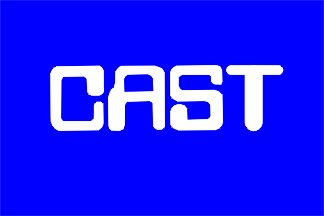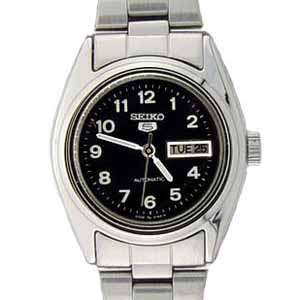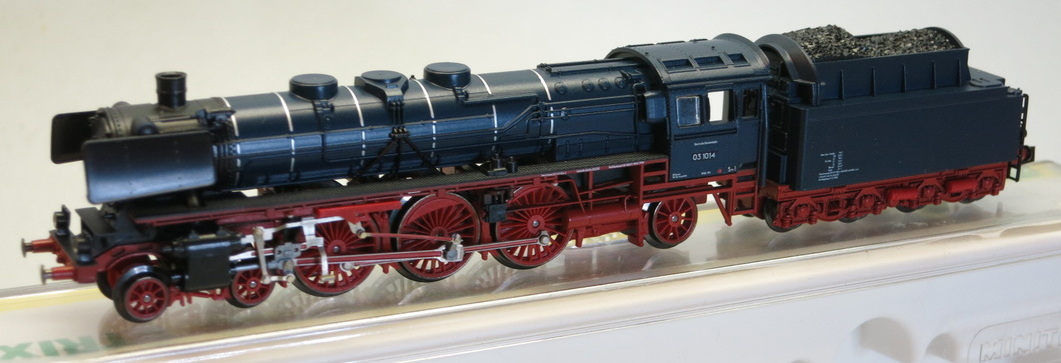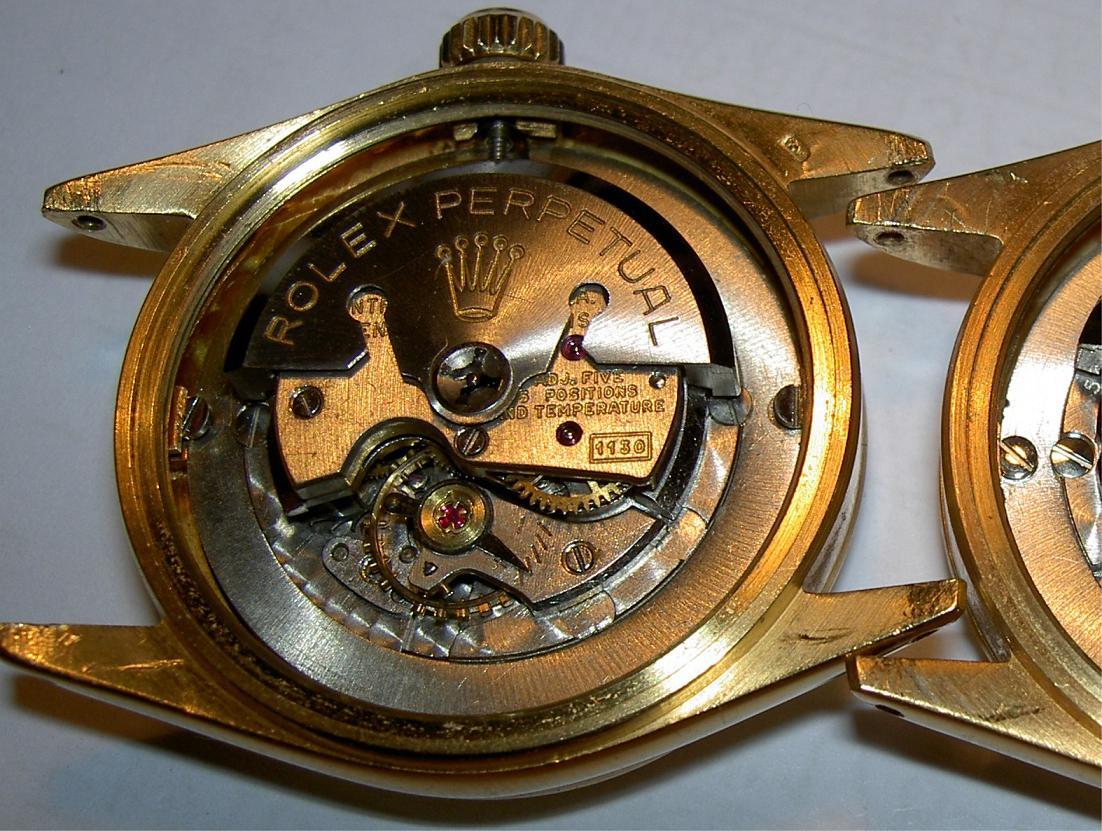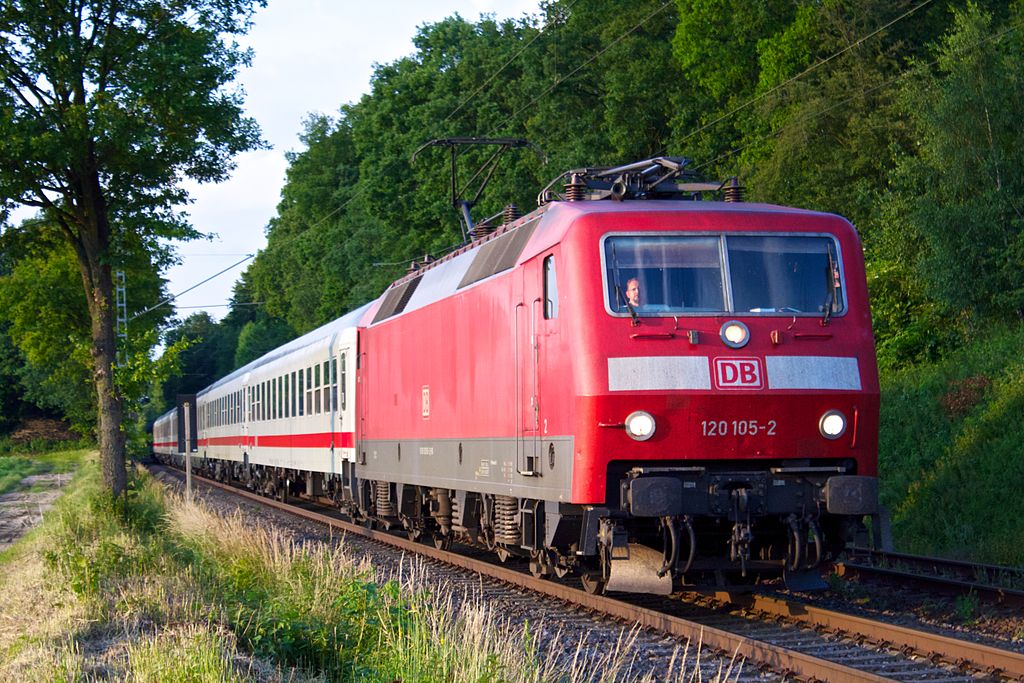Prototype History: The DB Baureihe 120 is a class of electric locomotives operated by DB Fernverkehr in Germany. The locomotives' prototypes, delivered in 1979 (Mark 120.0), were one of the first electric locomotives with three-phase motors. They were based on experiences made in the 1970s with diesel-electric test platforms (Mark DE 2500/ DB Mark 202). In Norway, a new four-axle Locomotive, Mark El-17, was launched during 1983 with top speeds up to 93 miles per hour (150 km/h).
The design was intended to be the first truly universal locomotive, capable of pulling fast passenger trains as well as heavy freight trains. While the electric equipment exceeded expectations, the mechanical part suffered from its lightweight construction necessitated by the heavy electronics of the time.
After extensive tests, a series of 60 locomotives (Mark 120.1) were ordered in 1984 and delivered in 1986 - 1988. Original plans to build up to 2,000 machines were ultimately ended by DB's privatisation. The 120s went to DB Fernverkehr, the other divisions of Deutsche Bahn ordered locomotives that featured technologies from the 120, but were not direct successors.
From Wikipedia
The design was intended to be the first truly universal locomotive, capable of pulling fast passenger trains as well as heavy freight trains. While the electric equipment exceeded expectations, the mechanical part suffered from its lightweight construction necessitated by the heavy electronics of the time.
After extensive tests, a series of 60 locomotives (Mark 120.1) were ordered in 1984 and delivered in 1986 - 1988. Original plans to build up to 2,000 machines were ultimately ended by DB's privatisation. The 120s went to DB Fernverkehr, the other divisions of Deutsche Bahn ordered locomotives that featured technologies from the 120, but were not direct successors.
From Wikipedia
Road Name History: 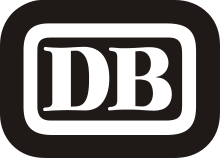 Deutsche Bundesbahn was the Western Germany DB before reunification. After World War II, Germany (and the DRG) was divided into 4 zones: US, British, French and Soviet. The first three eventually combined to form the Federal Republic of Germany (the West) and the Russian zone became the German Democratic Republic (the East). German territories beyond the Oder were ceded to Poland except for the northern part of East Prussia, which was ceded to the Soviet Union in 1945.
Deutsche Bundesbahn was the Western Germany DB before reunification. After World War II, Germany (and the DRG) was divided into 4 zones: US, British, French and Soviet. The first three eventually combined to form the Federal Republic of Germany (the West) and the Russian zone became the German Democratic Republic (the East). German territories beyond the Oder were ceded to Poland except for the northern part of East Prussia, which was ceded to the Soviet Union in 1945.
From 1949, the new governments assumed authority for railway operations. The DRG's (or DR's) successors were named Deutsche Bundesbahn (DB, German Federal Railways) in West Germany, and Deutsche Reichsbahn (DR, German State Railways) in East Germany kept the old name to hold tracking rights in western Berlin.
Unlike the DRG, which was a corporation, both the DB and the DR were federal state institutions, directly controlled by their respective transportation ministries. Railway service between East and West was restricted; there were around five well-controlled and secure checkpoints between West and East Germany, and about the same number between East Germany and West Berlin. Four transit routes existed between West Germany and West Berlin; citizens of West Berlin and West Germany were able to use these without too much harassment by the East German authorities.
The DB started in 1968 with changing the locomotive and passenger car serial numbers to the UIC norm. In 1970 the DR followed. The DB started experimenting with the Intercity trains in a new livery (bright orange).
In 1989, the Wall fell. Train frequency rapidly increased on the existing East/West corridors; closed links which had formerly crossed the border were re-opened. On 3 October 1990, Germany was reunified; however, this was not immediately the case with the railways. Administrative and organisational problems led to the decision to completely re-organize and reconnect Germany's railways. The so-called Bahnreform (Railway Reform) came into effect on 1 January 1994, when the State railways Deutsche Bundesbahn and Deutsche Reichsbahn were formally reunited to form the current German Railway Corporation (Deutsche Bahn).
From Wikipedia

From 1949, the new governments assumed authority for railway operations. The DRG's (or DR's) successors were named Deutsche Bundesbahn (DB, German Federal Railways) in West Germany, and Deutsche Reichsbahn (DR, German State Railways) in East Germany kept the old name to hold tracking rights in western Berlin.
Unlike the DRG, which was a corporation, both the DB and the DR were federal state institutions, directly controlled by their respective transportation ministries. Railway service between East and West was restricted; there were around five well-controlled and secure checkpoints between West and East Germany, and about the same number between East Germany and West Berlin. Four transit routes existed between West Germany and West Berlin; citizens of West Berlin and West Germany were able to use these without too much harassment by the East German authorities.
The DB started in 1968 with changing the locomotive and passenger car serial numbers to the UIC norm. In 1970 the DR followed. The DB started experimenting with the Intercity trains in a new livery (bright orange).
In 1989, the Wall fell. Train frequency rapidly increased on the existing East/West corridors; closed links which had formerly crossed the border were re-opened. On 3 October 1990, Germany was reunified; however, this was not immediately the case with the railways. Administrative and organisational problems led to the decision to completely re-organize and reconnect Germany's railways. The so-called Bahnreform (Railway Reform) came into effect on 1 January 1994, when the State railways Deutsche Bundesbahn and Deutsche Reichsbahn were formally reunited to form the current German Railway Corporation (Deutsche Bahn).
From Wikipedia
Brand/Importer Information: Gebr. Märklin & Cie. GmbH or Märklin (MÄRKLIN or MAERKLIN in capital letters) is a German toy company. The company was founded in 1859 and is based at Göppingen in Baden-Württemberg. Although it originally specialized in doll house accessories, today it is best known for model railways and technical toys. In some parts of Germany and in Sweden, the company's name is almost synonymous with model railroads.
Märklin introduced Z Scale in 1972. Connoisseurs appreciate Märklin Z as much as the most inveterate modeler: The charm of these finely constructed gems is best seen in the smallest of space. Because, this scale with all kinds of precision translated into 1:220 scale awaits you with almost unlimited operating enjoyment. It doesn't get any better.
Märklin introduced Z Scale in 1972. Connoisseurs appreciate Märklin Z as much as the most inveterate modeler: The charm of these finely constructed gems is best seen in the smallest of space. Because, this scale with all kinds of precision translated into 1:220 scale awaits you with almost unlimited operating enjoyment. It doesn't get any better.
Item created by: CNW400 on 2022-07-07 16:29:15
If you see errors or missing data in this entry, please feel free to log in and edit it. Anyone with a Gmail account can log in instantly.
If you see errors or missing data in this entry, please feel free to log in and edit it. Anyone with a Gmail account can log in instantly.




